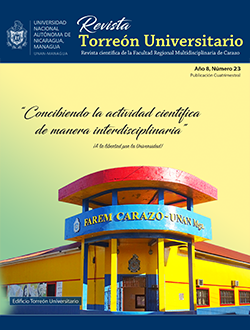Identification and quantification of pesticide residues in vegetables of high consumption commercialized in markets and supermarkets in Managua
DOI:
https://doi.org/10.5377/torreon.v8i23.9532Keywords:
codex alimentarius, maximum residues limits, pesticides, plant matrixAbstract
The use of pesticides for pest control is a common practice in agricultural production systems of Nicaragua. In this study 21 pesticides (7 organophosphorus insecticides, 1 organochlorine insecticide, 3 pyrethroid insecticides, 7 herbicides and 3 fungicides) were studied and determined in samples of tomatoes, peppers, lettuce and cabbage collected in 2 popular markets and 2 supermarkets of Managua. The analysis reflects that 55,0% of the samples contain pesticides, managing to identify residues of chlorpyrifos, mocap, cypermethrin, chlorothalonil, imazalil, diazinon, deltamethrin, simazine and 2,4-D, in concentrations between 0,005 mg/kg up to 5,3 mg/kg. 20,0% of the samples contain residual variables that exceed the values established in the Codex Alimentarius in the matrices lettuce (diazinon), cabbage (chlorpyrifos and diazinon), tomato (mocap and deltamethrin).
Downloads
Downloads
Published
How to Cite
Issue
Section
License
Los autores que publican en esta revista están de acuerdo con los siguientes términos.
- El autor o los autores de los artículos, ensayos o investigaciones conceden a la Universidad Nacional Autónoma de Nicaragua, Managua (UNAN-Managua) los derechos de edición (copyright) del trabajo enviado, por consiguiente la Universidad cuenta con el derecho exclusivo para publicar el artículo durante el periodo completo de los derechos de autor.
- Estos derechos de autor/ autores autorizan a la Revista Torreón Universitario y a la Universidad editar y divulgar/publicar el artículo en dicha Revista, incluyendo reproducción impresa y electrónica, el almacenamiento, recuperación y cualquier otro tipo de publicación, y fuentes de información secundaria como servicios de resúmenes y bases de datos, así mismo la facultan a proteger el artículo contra el uso no autorizado para su difusión por medios impresos o electrónicos (PDF, HTML, EPUB, XML u otros).
Licencia para el uso del contenido
La revista hace uso de la Licencia Creative Commons Atribución-NoComercial-SinDerivar 4.0 Internacional.
Bajo esta declaración:

Este revista está sujeta a una licencia de Creative Commons Reconocimiento-NoComercial-SinObraDerivada 4.0 Internacional. Puede ser copiada, distribuida y transmitida públicamente siempre y cuando se cite al autor y la fuente (Revista Torreón Universitario), no debe modificarse ni utilizarse con ningún fin comercial. La licencia completa se puede consultar en http://creativecommons.org/licenses/by-nc-nd/4.0/.

